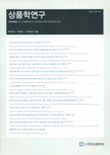- 영문명
- 발행기관
- 한국상품학회
- 저자명
- Chae SungzinㆍRoh Da-un
- 간행물 정보
- 『상품학연구』제30권 제6호, 89~100쪽, 전체 12쪽
- 주제분류
- 경제경영 > 경영학
- 파일형태
- 발행일자
- 2012.11.30

국문 초록
영문 초록
This study explores three cases of modern Korean commodity of vernacular design: the Kimchi refrigerator, the rice cooker, and the floor heating system. A new perspective on vernacular design evolution as contemporary high-tech products of necessities is then proposed in a local context. The design of vernacular commodity for the artificial world is the topic of the book Architecture without Architects, by Bernard Rudofsky, written in 1964. It attempts to break down our narrow concepts of building art by introducing the unfamiliar world of non-pedigreed architecture. In equal terms, this idea can be adopted to modern commodity of product design area. For want of a generic label, we have called it vernacular, anonymous, spontaneous, indigenous, rural, and local as the casemight be. For Koreans it is a remote area formulti-national corporations or global star designers to design appliances and facilities related to life’s indispensable staples. Examples include the Kimchi refrigerator, the rice cooker, and floor heating system. Highly educated local designers are developing and commanding the design of local staples andmodern vernacular design projects, adapting series of professional conventions of their locality and paying substantial attention to what may be fashionable as well as useful for their neighbor customers.
목차
Abstract
I. The Kimchi Jar and the Kimchi Refrigerator
II. Pig Iron Jar and a High-tech Pressure Pot
III. Ondol and the Heated Stone Bed
IV. Conclusion
V. Findings and Implications
References
Appendix
해당간행물 수록 논문
참고문헌
최근 이용한 논문
교보eBook 첫 방문을 환영 합니다!

신규가입 혜택 지급이 완료 되었습니다.
바로 사용 가능한 교보e캐시 1,000원 (유효기간 7일)
지금 바로 교보eBook의 다양한 콘텐츠를 이용해 보세요!


